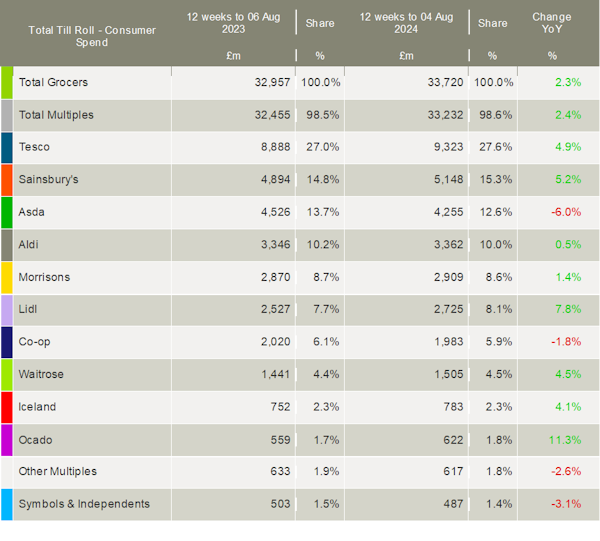Latest data from Kantar shows that take-home sales at the UK’s leading grocers rose by 3.8% in the four weeks to 4 August, boosted by the summer of sport and the first uptick in grocery inflation since March 2023
Commenting on the rise to 1.8%, up from 1.6% last month, Fraser McKevitt, head of retail and consumer insight at Kantar, said: “Having reached its lowest rate in almost three years in July, August saw inflation nudge up again slightly. While this is noticeable following 17 straight months of falling rates, it actually marks a return to the average levels seen in the five years before the start of the cost of living crisis.”
The data shows it was a mixed picture on supermarket shelves, with prices rising across 182 product categories and falling in 89 others. For example, kitchen towels and baked beans are now 7% and 5% cheaper respectively than they were last year. McKevitt added: “With this kind of pricing spread, shoppers will find that the type of product they’re putting in their baskets will really dictate how much they pay. They’re continuing to take advantage of the wide range of promotions being offered by the grocers to help keep the price of shopping down. Spending on deals rose by 15%, while sales of products at their usual price saw no increase.”
Despite the ongoing financial pressures, consumers appear to have celebrated the summer of sport. Many marked the start of the Olympics over drinks and snacks – sales of wine were up 35%, while nuts increased by 60%, and crisps rose by 10% on the Friday of the opening ceremony in Paris, compared with the previous week. Meanwhile, as the men’s UEFA European Football Championship reached its closing stages, £10m was spent on beer on the day of the final, the most spent on a Sunday in more than three years.
McKevitt commented: “While people continue to make smart choices to manage their budgets, we should never underestimate Britons’ love of big occasions.”
Looking at individual retailer performances, Sainsbury’s market share rose by 0.5 percentage points over the 12 weeks to 4 August – its largest year-on-year gain since July 1997. It was again the fastest growing of the traditional supermarkets, with sales increasing by 5.2%.
Tesco also maintained its streak of winning share every month since August 2023. Its hold of the market climbed by 0.6 percentage points to 27.6% after its sales climbed 4.9%.
Asda continued to struggle, with its sales sliding 6.0% and market share falling to 12.6% compared to 13.7% last year. Morrisons’ share edged down to 8.6% after a 1.4% rise in sales.
Buoyed by a 7.8% boost in sales, Lidl won an extra 0.4 percentage points of the market, taking its share to 8.1%. However, Aldi’s share slipped from 10.2% to 10.0% after its sales rose only 0.5%.
Sales were up 11.3% at Ocado, continuing its six-month run as the fastest-growing grocer in the UK. Its share increased by 0.1 percentage point compared with last year, now standing at 1.8%.
Waitrose’s share edged up 0.1 percentage point to 4.5% after its sales rose 4.5% – its strongest growth since November 2023.

NAM Implications:
- Latest inflation rate “actually marks a return to the average levels seen in the five years before the start of the cost of living crisis.”
- i.e. Inflation level normal…
- Consumers are shopping around for the best deals.
- Tesco and Sainsbury’s growing share at the expense of Asda and Morrisons’
- The Aldi-Lidl combined share of 18.1% must continue to be of concern to the mults, despite the loyalty promos.
- Overall, suppliers maintaining their fair share of the above players will be as good as it gets…



